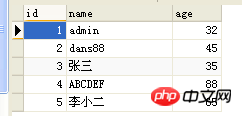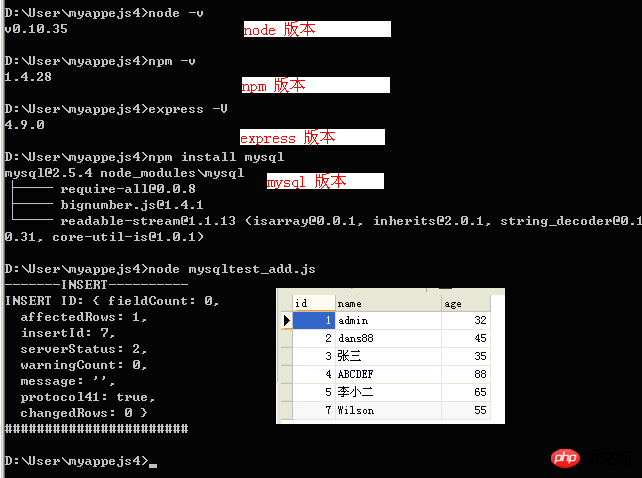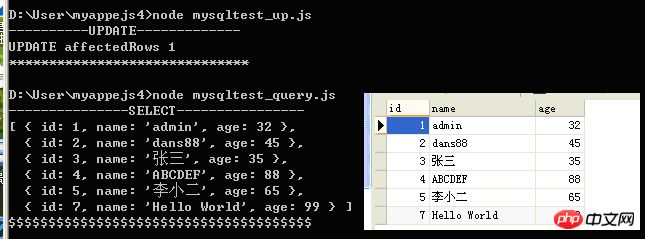Use Nodejs to connect to mysql to implement basic operations
This article mainly introduces the method of Nodejs connecting to mysql and realizing the operations of adding, deleting, modifying and querying. It combines the example form with a detailed analysis of the connection of nodejs to mysql database, the creation of mysql database and the nodejs adding, deleting, modifying and querying of mysql. For specific implementation skills of related operations, friends in need can refer to
This article describes how Nodejs connects to mysql and implements add, delete, modify, and check operations. Share it with everyone for your reference, the details are as follows:
1. Prepare
nodejs tutorials, most of which use mongodb as an example. However, mongodb has some limitations, which are stated on the official website. I plan to use MySQL because I still have some experience using it. Focus on research first. node-mysql is currently the most popular mysql driver under node. I used it initially, because the asynchronous callback method really has a lot of pitfalls.
The package name of the following project is mysql, and the version is mysql@ 2.5.4
First explain the code shown below, which all starts with the following code, and will not be explained later
var connection = mysql.createConnection({
host : '127.0.0.1',
user : 'root',
password : 'root123',
port: '3306',
database: 'my_news_test',
});The meaning of the code is very straightforward. If you want to go deeper, you can go to the official website above to check. Configurations such as host and user should be clear to those who have written MySQL database applications. Please modify the corresponding parameters by yourself. The following code assumes that there is a table called node_use in the database "my_news_test". The table has 3 attributes
id: auto-increment primary key
name: The name has unique restrictions.
age: Age
Test MySQL MySQL version: 5.5
2. Create a database and insert 5 entries Record
Source Database : my_news_test SET FOREIGN_KEY_CHECKS=0; -- ---------------------------- -- Table structure for node_user -- ---------------------------- DROP TABLE IF EXISTS `node_user`; CREATE TABLE `node_user` ( `id` int(11) NOT NULL AUTO_INCREMENT, `name` varchar(30) DEFAULT NULL, `age` int(8) DEFAULT NULL, PRIMARY KEY (`id`) ) ENGINE=InnoDB AUTO_INCREMENT=6 DEFAULT CHARSET=utf8; -- ---------------------------- -- Records of node_user -- ---------------------------- INSERT INTO `node_user` VALUES ('1', 'admin', '32'); INSERT INTO `node_user` VALUES ('2', 'dans88', '45'); INSERT INTO `node_user` VALUES ('3', '张三', '35'); INSERT INTO `node_user` VALUES ('4', 'ABCDEF', '88'); INSERT INTO `node_user` VALUES ('5', '李小二', '65');
3. Test the environment first
1. First you need to install the mysql package of nodejs
D:\User\myappejs4>npm install mysql mysql@2.5.4 node_modules\mysql ├── require-all@0.0.8 ├── bignumber.js@1.4.1 └── readable-stream@1.1.13 (inherits@2.0.1, string_decoder@0.10.31, isarray@0 .0.1, core-util-is@1.0.1)
2. Write code for interaction between nodejs and mysql
//mysql.js
//首先需要安装nodejs 的mysql包
//npm install mysql
//编写nodejs与mysql交互的代码
var mysql = require('mysql');
var TEST_DATABASE = 'my_news_test';
var TEST_TABLE = 'node_user';
//创建连接
var client = mysql.createConnection({
user: 'root',
password: 'root123',
});
client.connect();
client.query("use " + TEST_DATABASE);
client.query(
'SELECT * FROM '+TEST_TABLE,
function selectCb(err, results, fields) {
if (err) {
throw err;
}
if(results)
{
for(var i = 0; i < results.length; i++)
{
console.log("%d\t%s\t%s", results[i].id, results[i].name, results[i].age);
}
}
client.end();
}
);3. Running results
D:\User\myappejs4>node mysqltest.js 1 admin 32 2 dans88 45 3 张三 35 4 ABCDEF 88 5 李小二 65

4. Node. js combined with MySQL's add, delete, modify, and query operations
1, add
var mysql = require('mysql');
var connection = mysql.createConnection({
host : '127.0.0.1',
user : 'root',
password : 'root123',
port: '3306',
database: 'my_news_test',
});
connection.connect();
var userAddSql = 'INSERT INTO node_user(id,name,age) VALUES(0,?,?)';
var userAddSql_Params = ['Wilson', 55];
//增 add
connection.query(userAddSql,userAddSql_Params,function (err, result) {
if(err){
console.log('[INSERT ERROR] - ',err.message);
return;
}
console.log('-------INSERT----------');
//console.log('INSERT ID:',result.insertId);
console.log('INSERT ID:',result);
console.log('#######################');
});
connection.end();run as follows
D:\User\myappejs4>node mysqltestadd.js
-------INSERT----------
INSERT ID: { fieldCount: 0,
affectedRows: 1,
insertId: 6,
serverStatus: 2,
warningCount: 0,
message: '',
protocol41: true,
changedRows: 0 }
#######################
2. Change
var mysql = require('mysql');
var connection = mysql.createConnection({
host : '127.0.0.1',
user : 'root',
password : 'root123',
port: '3306',
database: 'my_news_test',
});
connection.connect();
var userModSql = 'UPDATE node_user SET name = ?,age = ? WHERE id = ?';
var userModSql_Params = ['Hello World',99,7];
//改 up
connection.query(userModSql,userModSql_Params,function (err, result) {
if(err){
console.log('[UPDATE ERROR] - ',err.message);
return;
}
console.log('----------UPDATE-------------');
console.log('UPDATE affectedRows',result.affectedRows);
console.log('******************************');
});
connection.end();and the running result is as follows
D:\User\myappejs4>node mysqltest_up.js ----------UPDATE------------- UPDATE affectedRows 1 ******************************
3. Check the operation
var mysql = require('mysql');
var connection = mysql.createConnection({
host : '127.0.0.1',
user : 'root',
password : 'root123',
port: '3306',
database: 'my_news_test',
});
connection.connect();
var userGetSql = 'SELECT * FROM node_user';
//查 query
connection.query(userGetSql,function (err, result) {
if(err){
console.log('[SELECT ERROR] - ',err.message);
return;
}
console.log('---------------SELECT----------------');
console.log(result);
console.log('$$$$$$$$$$$$$$$$$$$$$$$$$$$$$$$$$$$$$$');
});
connection.end();and the running result is as follows
D:\User\myappejs4>node mysqltest_query.js
---------------SELECT----------------
[ { id: 1, name: 'admin', age: 32 },
{ id: 2, name: 'dans88', age: 45 },
{ id: 3, name: '张三', age: 35 },
{ id: 4, name: 'ABCDEF', age: 88 },
{ id: 5, name: '李小二', age: 65 },
{ id: 6, name: 'Wilson', age: 55 } ]
$$$$$$$$$$$$$$$$$$$$$$$$$$$$$$$$$$$$$$
4. Delete operation
var mysql = require('mysql');
var connection = mysql.createConnection({
host : '127.0.0.1',
user : 'root',
password : 'root123',
port: '3306',
database: 'my_news_test',
});
connection.connect();
var userDelSql = 'DELETE FROM node_user WHERE id = 7';
//ɾ
connection.query(userDelSql,function (err, result) {
if(err){
console.log('[DELETE ERROR] - ',err.message);
return;
}
console.log('-------------DELETE--------------');
console.log('DELETE affectedRows',result.affectedRows);
console.log('&&&&&&&&&&&&&&&&&');
});
connection.end();
运行的结果如下
D:\User\myappejs4>node mysqltest_del.js
-------------DELETE--------------
DELETE affectedRows 1
&&&&&&&&&&&&&&&&&&&&&&&&&&&&&&&&&&
The above is what I compiled for everyone. I hope it will be helpful to everyone in the future.
Related articles:
How to package static resources in vue
What are the usages of async&await in Koa2?
In the zTree tree plug-in, how to implement click-loading in five-level regions across the country
How to implement node express personalized chat rooms?
The above is the detailed content of Use Nodejs to connect to mysql to implement basic operations. For more information, please follow other related articles on the PHP Chinese website!

Hot AI Tools

Undresser.AI Undress
AI-powered app for creating realistic nude photos

AI Clothes Remover
Online AI tool for removing clothes from photos.

Undress AI Tool
Undress images for free

Clothoff.io
AI clothes remover

Video Face Swap
Swap faces in any video effortlessly with our completely free AI face swap tool!

Hot Article

Hot Tools

Notepad++7.3.1
Easy-to-use and free code editor

SublimeText3 Chinese version
Chinese version, very easy to use

Zend Studio 13.0.1
Powerful PHP integrated development environment

Dreamweaver CS6
Visual web development tools

SublimeText3 Mac version
God-level code editing software (SublimeText3)

Hot Topics
 1653
1653
 14
14
 1413
1413
 52
52
 1305
1305
 25
25
 1251
1251
 29
29
 1224
1224
 24
24
 MySQL's Role: Databases in Web Applications
Apr 17, 2025 am 12:23 AM
MySQL's Role: Databases in Web Applications
Apr 17, 2025 am 12:23 AM
The main role of MySQL in web applications is to store and manage data. 1.MySQL efficiently processes user information, product catalogs, transaction records and other data. 2. Through SQL query, developers can extract information from the database to generate dynamic content. 3.MySQL works based on the client-server model to ensure acceptable query speed.
 How to start mysql by docker
Apr 15, 2025 pm 12:09 PM
How to start mysql by docker
Apr 15, 2025 pm 12:09 PM
The process of starting MySQL in Docker consists of the following steps: Pull the MySQL image to create and start the container, set the root user password, and map the port verification connection Create the database and the user grants all permissions to the database
 Laravel Introduction Example
Apr 18, 2025 pm 12:45 PM
Laravel Introduction Example
Apr 18, 2025 pm 12:45 PM
Laravel is a PHP framework for easy building of web applications. It provides a range of powerful features including: Installation: Install the Laravel CLI globally with Composer and create applications in the project directory. Routing: Define the relationship between the URL and the handler in routes/web.php. View: Create a view in resources/views to render the application's interface. Database Integration: Provides out-of-the-box integration with databases such as MySQL and uses migration to create and modify tables. Model and Controller: The model represents the database entity and the controller processes HTTP requests.
 Solve database connection problem: a practical case of using minii/db library
Apr 18, 2025 am 07:09 AM
Solve database connection problem: a practical case of using minii/db library
Apr 18, 2025 am 07:09 AM
I encountered a tricky problem when developing a small application: the need to quickly integrate a lightweight database operation library. After trying multiple libraries, I found that they either have too much functionality or are not very compatible. Eventually, I found minii/db, a simplified version based on Yii2 that solved my problem perfectly.
 How to install mysql in centos7
Apr 14, 2025 pm 08:30 PM
How to install mysql in centos7
Apr 14, 2025 pm 08:30 PM
The key to installing MySQL elegantly is to add the official MySQL repository. The specific steps are as follows: Download the MySQL official GPG key to prevent phishing attacks. Add MySQL repository file: rpm -Uvh https://dev.mysql.com/get/mysql80-community-release-el7-3.noarch.rpm Update yum repository cache: yum update installation MySQL: yum install mysql-server startup MySQL service: systemctl start mysqld set up booting
 Laravel framework installation method
Apr 18, 2025 pm 12:54 PM
Laravel framework installation method
Apr 18, 2025 pm 12:54 PM
Article summary: This article provides detailed step-by-step instructions to guide readers on how to easily install the Laravel framework. Laravel is a powerful PHP framework that speeds up the development process of web applications. This tutorial covers the installation process from system requirements to configuring databases and setting up routing. By following these steps, readers can quickly and efficiently lay a solid foundation for their Laravel project.
 MySQL and phpMyAdmin: Core Features and Functions
Apr 22, 2025 am 12:12 AM
MySQL and phpMyAdmin: Core Features and Functions
Apr 22, 2025 am 12:12 AM
MySQL and phpMyAdmin are powerful database management tools. 1) MySQL is used to create databases and tables, and to execute DML and SQL queries. 2) phpMyAdmin provides an intuitive interface for database management, table structure management, data operations and user permission management.
 Centos install mysql
Apr 14, 2025 pm 08:09 PM
Centos install mysql
Apr 14, 2025 pm 08:09 PM
Installing MySQL on CentOS involves the following steps: Adding the appropriate MySQL yum source. Execute the yum install mysql-server command to install the MySQL server. Use the mysql_secure_installation command to make security settings, such as setting the root user password. Customize the MySQL configuration file as needed. Tune MySQL parameters and optimize databases for performance.




